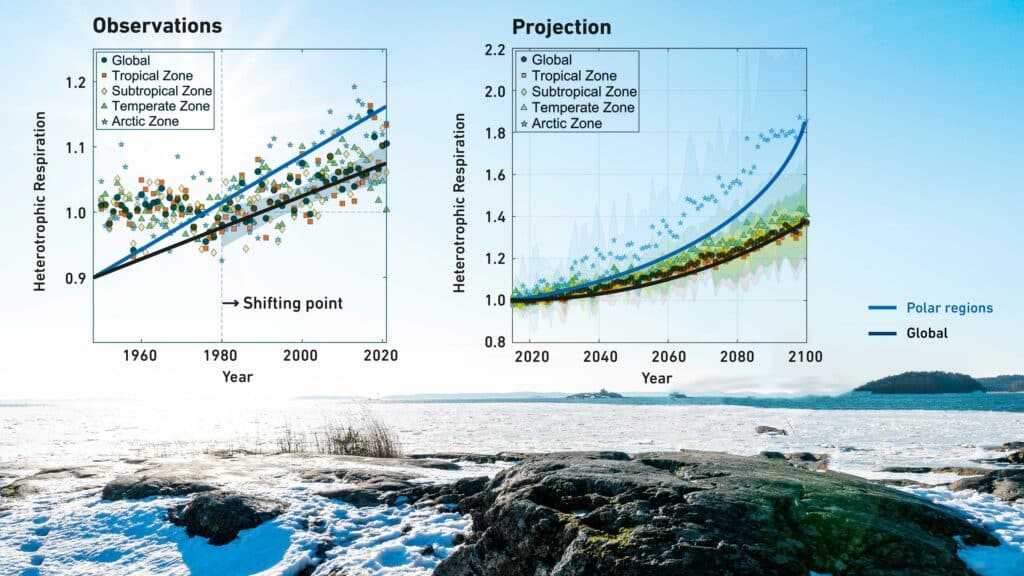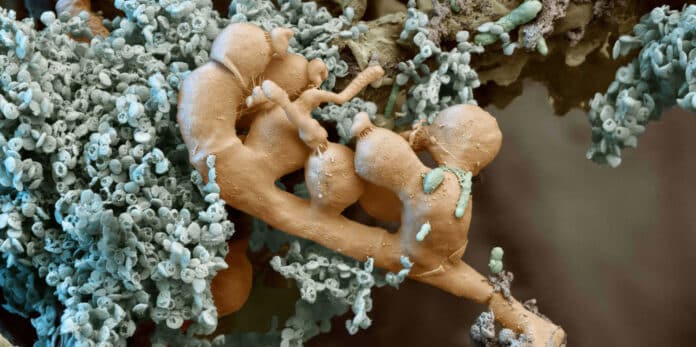The greatest terrestrial carbon supplier to the atmosphere, carbon efflux from soils is nevertheless one of the Earth’s carbon budget’s least predictable fluxes. A dominant component of this flux is heterotrophic respiration- a process in which CO2 is released into the atmosphere- influenced by several environmental factors, notably soil temperature and moisture.
It is projected that CO2 emissions from soil microbes will escalate by the end of the century. Recently, scientists from – ETH Zurich, the Swiss Federal Institute for Forest, Snow and Landscape Research WSL, the Swiss Federal Institute of Aquatic Science and Technology Eawag, and the University of Lausanne– have developed a model from micro to a global scale to explore how changes in soil water content and temperature affect soil heterotrophic respiration. The model shows these emissions could surge by up to 40 percent by the end of the century – most significantly in the polar regions.
The study emphasizes the urgent need for more accurate estimates of the heterotrophic respiration rates. Besides confirming previous studies, the study offers precise insights into the mechanisms and magnitude of heterotrophic soil respiration across different climatic zones.
Unlike other models, relying on numerous parameters, this newly developed model uses two important environmental factors: soil moisture and temperature. The model is an important advance since it considers all biophysically important levels, from the smallest scales of soil structure and water distribution to the largest sizes of entire ecosystems, climatic zones, and even the entire planet.
Peter Molnar, a professor at the ETH Institute of Environmental Engineering, highlights the significance of this theoretical model, which complements large Earth System models, stating, “The model allows for a more straightforward estimation of microbial respiration rates based on soil moisture and soil temperature. Moreover, it enhances our understanding of how heterotrophic respiration in diverse climate regions contributes to global warming.”

One important discovery is that the rise in microbial CO2 emissions differs among climate zones. In contrast to hot and temperate regions, where temperature increases significantly, the main factor driving the increase in cold polar regions is a loss in soil moisture.
Alon Nissan highlights the sensitivity of cold zones, stating, “Even a slight change in water content can lead to a substantial alteration in the respiration rate in the polar regions.”
According to their calculations, microbial CO2 emissions in polar regions are expected to increase by 10% per decade by 2100, twice the pace expected for the rest of the world under the worst-case climatic scenario. This discrepancy is because the best circumstances for heterotrophic respiration are found when soils are semi-saturated or neither too dry nor too wet. In arctic regions, these circumstances are present when soil is thawing.
However, the rise in microbial CO2 emissions is far less pronounced in soils from other climate zones, which are already considerably drier and more susceptible to further desiccation. Regardless of climate zone, the temperature has a constant effect: microbial CO2 emissions follow suit when soil temperature rises.
By 2021, the warm regions of the Earth will be the main source of most CO2 emissions from soil microorganisms. Particularly, 67 percent of these emissions originate in tropical areas, compared to 23 percent in subtropical areas, 10 percent in temperate zones, and hardly 0.1 percent in arctic or polar regions.
Scientists noted, “Substantial growth in microbial CO2 emissions across all these regions compared to the levels observed in 2021. By the year 2100, their projections indicate an increase of 119 percent in the polar regions, 38 percent in the tropics, 40 percent in the subtropics, and 48 percent in the temperate zones.”
Journal Reference:
- Nissan, A., Alcolombri, U., Peleg, N. et al. Global warming accelerates soil heterotrophic respiration. Nature Communications 14, 3452 (2023). DOI: 10.1038/s41467-023-38981-w
